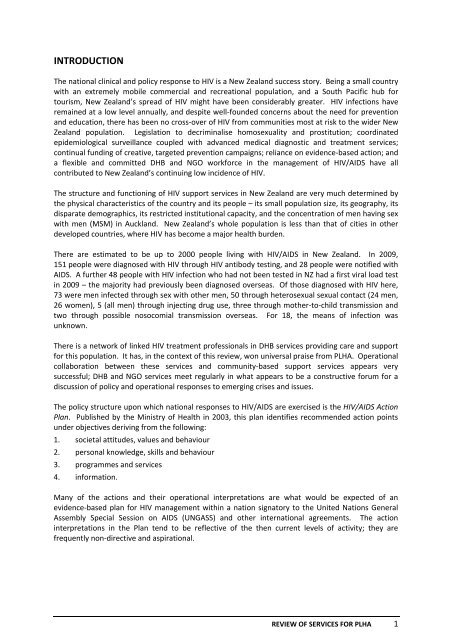Review of services for people living with HIV in New Zealand
Review of services for people living with HIV in New Zealand
Review of services for people living with HIV in New Zealand
- No tags were found...
Create successful ePaper yourself
Turn your PDF publications into a flip-book with our unique Google optimized e-Paper software.
INTRODUCTIONThe national cl<strong>in</strong>ical and policy response to <strong>HIV</strong> is a <strong>New</strong> <strong>Zealand</strong> success story. Be<strong>in</strong>g a small country<strong>with</strong> an extremely mobile commercial and recreational population, and a South Pacific hub <strong>for</strong>tourism, <strong>New</strong> <strong>Zealand</strong>’s spread <strong>of</strong> <strong>HIV</strong> might have been considerably greater. <strong>HIV</strong> <strong>in</strong>fections haverema<strong>in</strong>ed at a low level annually, and despite well‐founded concerns about the need <strong>for</strong> preventionand education, there has been no cross‐over <strong>of</strong> <strong>HIV</strong> from communities most at risk to the wider <strong>New</strong><strong>Zealand</strong> population. Legislation to decrim<strong>in</strong>alise homosexuality and prostitution; coord<strong>in</strong>atedepidemiological surveillance coupled <strong>with</strong> advanced medical diagnostic and treatment <strong>services</strong>;cont<strong>in</strong>ual fund<strong>in</strong>g <strong>of</strong> creative, targeted prevention campaigns; reliance on evidence‐based action; anda flexible and committed DHB and NGO work<strong>for</strong>ce <strong>in</strong> the management <strong>of</strong> <strong>HIV</strong>/AIDS have allcontributed to <strong>New</strong> <strong>Zealand</strong>’s cont<strong>in</strong>u<strong>in</strong>g low <strong>in</strong>cidence <strong>of</strong> <strong>HIV</strong>.The structure and function<strong>in</strong>g <strong>of</strong> <strong>HIV</strong> support <strong>services</strong> <strong>in</strong> <strong>New</strong> <strong>Zealand</strong> are very much determ<strong>in</strong>ed bythe physical characteristics <strong>of</strong> the country and its <strong>people</strong> – its small population size, its geography, itsdisparate demographics, its restricted <strong>in</strong>stitutional capacity, and the concentration <strong>of</strong> men hav<strong>in</strong>g sex<strong>with</strong> men (MSM) <strong>in</strong> Auckland. <strong>New</strong> <strong>Zealand</strong>’s whole population is less than that <strong>of</strong> cities <strong>in</strong> otherdeveloped countries, where <strong>HIV</strong> has become a major health burden.There are estimated to be up to 2000 <strong>people</strong> <strong>liv<strong>in</strong>g</strong> <strong>with</strong> <strong>HIV</strong>/AIDS <strong>in</strong> <strong>New</strong> <strong>Zealand</strong>. In 2009,151 <strong>people</strong> were diagnosed <strong>with</strong> <strong>HIV</strong> through <strong>HIV</strong> antibody test<strong>in</strong>g, and 28 <strong>people</strong> were notified <strong>with</strong>AIDS. A further 48 <strong>people</strong> <strong>with</strong> <strong>HIV</strong> <strong>in</strong>fection who had not been tested <strong>in</strong> NZ had a first viral load test<strong>in</strong> 2009 – the majority had previously been diagnosed overseas. Of those diagnosed <strong>with</strong> <strong>HIV</strong> here,73 were men <strong>in</strong>fected through sex <strong>with</strong> other men, 50 through heterosexual sexual contact (24 men,26 women), 5 (all men) through <strong>in</strong>ject<strong>in</strong>g drug use, three through mother‐to‐child transmission andtwo through possible nosocomial transmission overseas. For 18, the means <strong>of</strong> <strong>in</strong>fection wasunknown.There is a network <strong>of</strong> l<strong>in</strong>ked <strong>HIV</strong> treatment pr<strong>of</strong>essionals <strong>in</strong> DHB <strong>services</strong> provid<strong>in</strong>g care and support<strong>for</strong> this population. It has, <strong>in</strong> the context <strong>of</strong> this review, won universal praise from PLHA. Operationalcollaboration between these <strong>services</strong> and community‐based support <strong>services</strong> appears verysuccessful; DHB and NGO <strong>services</strong> meet regularly <strong>in</strong> what appears to be a constructive <strong>for</strong>um <strong>for</strong> adiscussion <strong>of</strong> policy and operational responses to emerg<strong>in</strong>g crises and issues.The policy structure upon which national responses to <strong>HIV</strong>/AIDS are exercised is the <strong>HIV</strong>/AIDS ActionPlan. Published by the M<strong>in</strong>istry <strong>of</strong> Health <strong>in</strong> 2003, this plan identifies recommended action po<strong>in</strong>tsunder objectives deriv<strong>in</strong>g from the follow<strong>in</strong>g:1. societal attitudes, values and behaviour2. personal knowledge, skills and behaviour3. programmes and <strong>services</strong>4. <strong>in</strong><strong>for</strong>mation.Many <strong>of</strong> the actions and their operational <strong>in</strong>terpretations are what would be expected <strong>of</strong> anevidence‐based plan <strong>for</strong> <strong>HIV</strong> management <strong>with</strong><strong>in</strong> a nation signatory to the United Nations GeneralAssembly Special Session on AIDS (UNGASS) and other <strong>in</strong>ternational agreements. The action<strong>in</strong>terpretations <strong>in</strong> the Plan tend to be reflective <strong>of</strong> the then current levels <strong>of</strong> activity; they arefrequently non‐directive and aspirational.REVIEW OF SERVICES FOR PLHA 1
















